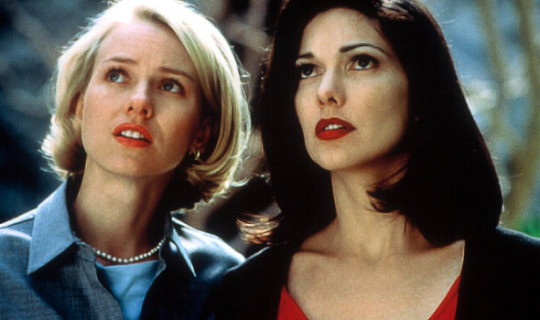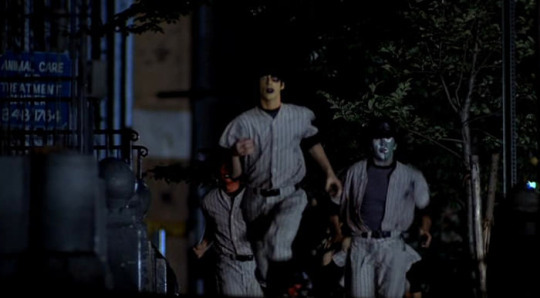In random order.
MULHOLLAND DR. (2001)

Mulholland Dr. basically is a broken TV pilot. There’s no structure, no arch; characters are introduced in grand, rich settings, only to abruptly disappear as the sequence of images that makes up this movie slowly unwinds, like forgotten thoughts. It’s an impressionistic movie, held together by a very stifling sense of danger. The two leads, Naomi Watts and Laura Harring, have always felt to me like twisted mirror images of Marilyn Monroe and Jane Russell in Gentlemen Prefer Blondes:

In fact, Laura Harring even wears a blonde wig at one point, just like Jane Russell in Gentlemen, in an attempt to mimic her companion:

But where Gentlemen Prefer Blondes is glittery and frivolous, Mulholland Dr. is dense and nightmarish. Every tear seems to hold weight. It’s a different kind of Hollywood; a town that has fallen between two realities, a carefully lit limbo in which the characters float and fade randomly, like ghosts. Books have been written about what it all means, but to me the pull of the film is exactly this vague, shadowy, old Tinseltown vibe, with its lonely suicides and stranded dreams. Naomi Watts’s character is named Betty, after Betty Grable I assume, and Diane, perhaps after the 1956 Lana Turner film; Laura Harring is Rita (Hayworth) and Camilla (as in Greta Garbo’s Camille (1936).) Maybe this is all claptrap–it probably is–but that a movie can inspire such claptrap, that’s a rare power. (After all, the Mona Lisa isn’t necessarily the greatest painting in the world.)
THE WIZ (1978)

From a nightmarish version of Hollywood we move to a nightmarish version of New York. The Wiz is a musical, but there’s nothing jolly about it. It’s a sinister film. Dorothy and her companions travel through a strangely empty city, where Art Deco has gone to die; and whenever they do encounter other characters, they are often hostile in a quiet but persistent way, casually cruel and colorful, like bizarre survivors of a nuclear holocaust. It seems like the clock is stuck at 6 o’clock in the evening: the sky is overcast, the streetlights are on, though they shine for nobody. Sometimes darkness falls, at random times. Everything seems broken, smashed to pieces, derelict, abandoned. There are subtle hints of racism: taxis drive off when black people approach them. Of course The Wiz isn’t a great film–it’s a failure in many ways–but it’s so wildly imaginative, and it so perfectly reflects the sounds and colors of my early childhood, that to me it’s a lost classic.
THE WARRIORS (1979)

I didn’t see The Warriors when it was released (I was too young, and anyway the film was an obscurity), yet it strongly evokes my childhood: that is, fears and fantasies I had about nighttime in the city. 1970s New York could be dangerous: it was the New York that superheroes wanted to clean up. The gangs in The Warriors (the “armies of the night” as the poster has it) consist of deadly clowns, and they’re gently being riled up against the heroes by a floating, seductive voice, a motherly voice, that fills the airwaves like that of an omnipresent dictator. She issues a soothing kill order. Seeing those pitch black streets and graffiti-riddled walls that form the backdrop to all this fighting and running, I’m reminded of this bit from Daniel Westlake’s 1972 novel Cops and Robbers:
“A recent fad among the kids has been to write nicknames on walls and subways and all over the damn place in either spray paint or felt-tip pen, both of which are very tough to get rid of, particularly from a porous surface like stone. The fad is for a kid to write his name or nickname or some magic name he’s worked out for himself, and then under it write the number of the street he lives on. “JUAN 135,” for instance, or “BOSS ZOOM 92,” that kind of thing.
The fad had hit the school building. As high as a child’s arm could reach, the names and numbers were scrawled everywhere on the walls, in black and red and blue and green and yellow. Some of the signatures were like little paintings, carefully and lovingly done, and some of them were just splashed and scrawled on, with runlets of paint dripping down from the bottoms of the letters, but most of them were simply reports of name and number, without flair or imagination: “Andy 87,” “Beth 81,” “Moro 103.”
At first, all that paintwork looked like vandalism and nothing more. But as I got used to it, to seeing it around, I realized it gave a brightly colored hem to the gray stone skirt of a building like this, that it had a very sunny Latin American flavor to it, and that once you got past the prejudice against working up public property it wasn’t that bad at all. Of course, I never said this to anybody.”
The film is supposedly based on Xenophon’s Anabasis (circa 370 BC), which goes to show that the purest classics don’t have a sense of time or place–they are eternally true.
This ends Part 1; Part 2 will follow shortly. Naturally, the reason I mention all these films is because they all, in various ways, have inspired me and ignited my own creative endeavours. What creative endeavours, you say? Why, how about my animation channel on YouTube, Tales from Weirdland:

No comments:
Post a Comment